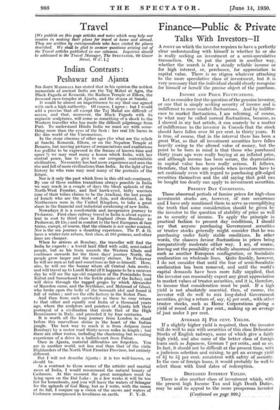Travel
[We publish on this page articles and notes which may help our readers in making their plans for travel at home and abroad. They are written by correspondents who have visited the places described. We shall be glad to answer questions arising out of the Travel articles published in our columns. Inquiries should be addressed to the Travel Manager, The SPECTATOR, 99 Gower
Street, W.C.1.]
Indian Contrasts : Peshawar and Ajanta
Sin JortN MnasuALL has stated that in his opinion the noblest memorials of ancient India are the Taj Mahal at Agra, the Black Pagoda at Konarak, the Kailasu Temple at Ellora, the frescoed cave-temples at Ajanta, and the stapas at Sanchi. It would be almost an impertinence to say that one agreed with such a high authority. Of course, I agree ; but I would add a proviso that all except the Taj Mahal are difficult of access, and that, moreover, the Black Pagoda with its orgiastic sculptures, will come as something of a shock to the Western traveller who has made the difficult pilgrimage from Puri. To understand Hindu India we must see with some- thing more than the eyes of the flesh : her real life burns in the dim world of the Unconscious, In the stone cinemas of other ages (for what are the reliefs at Sanchi, Konarak, Ellora, or on the Nepalese Temple at Benares, but moving pictures of renunciations and exaltations too godlike to be expressed in the frames of known time and space ?) we may read many a lesson which India, with her central peace, has to give to our arrogant, materialistic civilization. No country has had more experience and seen the rise and fall of more civilizations than India. In the light of her history he who runs may read many of the portents of the future.
Nor is it only the past which lives in this old sub-continent. By one of those sudden transitions always possible in India we may reach in a couple of days the bleak uplands of the North-West Frontier, and find hawk-eyed, hefty warriors (one of their tribes claims to be the Arackzai, the lost people of Israel) who are the Scots of Asia, and destined, as the Northerners were in the United Kingdom, to take a great share in the financial and industrial awakening of new India. - Nowadays it is a comfortable and inexpensive journey to Peshawar. First-class railway travel in India is about equiva- lent in -cost to third class in England (from Bombay to Peshawar, £9 15s.) and in comfort to the best European de luxe trains, except, of course, that the climate is not under control. Nor is the sea journey a daunting experience. The P. & 0. have a winter-rate return, first class, at 105 guineas, and other lines are cheaper.
When he arrives at Bombay, the traveller will find the India he expects : a torrid land filled with mild, semi-naked people, but as his train ascends the Western Ghats and continues onwards for the three days' journey North, the people grow larger and the country sterner. In Peshawar he will see men as tall and sometimes as fair as himself. Here, also, he will see the bazaar where all Central Asia meets ; and will travel up to Landi Kotal (if it happens to be a caravan day he will see the age-old migration of the Powindahs from Kabul and Samarkand to the fertile plains of the Indus), and will drive through the rugged gorges by which Alexander of Macedon came, and the Scythians, and Mahmud of Ghazi, who broke open the belly of the Somnath idol and found it full of rubies ; and see the rifle factory in the Kohat Pass. And then from such spectacles as these he may return to that other and equally real India of a thousand years ago, where the sculptors and painters of Ajanta left their portrayal of a civilization that rivals that of the High Renaissance in Italy, and preceded it by four centuries. It is worth all the long journey from London to stand before this marvellous shrine in the heart of the Indian jungle. The best way to reach it is from Julgaon (near Bombay) by a motor road thirty-seven miles in length ; but there are other routes, including the chastening but revealing experience of a drive in a bullock-cart from Palau.
Once in Ajanta, material difficulties are forgotten. You are in another world, not less real than that of the virile Highlanders of the North West Frontier Province, but entirely different.
But I will not describe Ajanta : it is too well-known, or should be.
As a contrast to these scenes of the artistic and martial races of India, I would recommend the natural beauty of Cashmere. At this moment the great nenuphars must be lying open on the Dal Lake • in a few weeks it will be too hot for houseboats, and you will leave the waters of Srinagar for the uplands of Gul Marg, but as I write, with the moon at its full, I conjure up a vision of the snows and waters of
Cashmere unsurpassed in loveliness on earth. F. Y.-B.


































 Previous page
Previous page